A 3D-Printed Bi-Material Bragg-Based Reflectarray Antenna
Abstract
:1. Introduction
2. Fully Dielectric Reflectarray Antenna Design
2.1. Bragg Reflector-Based Unit Cell
2.2. Reflectarray Design
3. Fabrication and Measurement
3.1. 3D-Printing with Dual Material
3.2. Radiation Measurement
- Spillover efficiency .
- Taper efficiency .
- Phase efficiency .
- Polarization efficiency .
- Blockage efficiency .
- Random error efficiency over the reflectarray surface.
- Material loss .
3.3. Comparison with State of the Art
4. Conclusions
Author Contributions
Funding
Institutional Review Board Statement
Informed Consent Statement
Data Availability Statement
Conflicts of Interest
References
- Huang, J.; Encinar, J. Reflectarray Antennas; Wiley: Hoboken, NJ, USA, 2007. [Google Scholar]
- Chaharmir, M.R.; Shaker, J.; Legay, H. Dual-band Ka/X reflectarray with broadband loop elements. IET Microwaves Antennas Propag. 2010, 4, 225–231. [Google Scholar] [CrossRef]
- Alsath, M.G.N.; Kanagasabai, M.; Arunkumar, S. Dual-Band Dielectric Resonator Reflectarray for C/X-Bands. IEEE Antennas Wirel. Propag. Lett. 2012, 11, 1253–1256. [Google Scholar] [CrossRef]
- Encinar, J.A.; Arrebola, M.; de la Fuente, L.F.; Toso, G. A Transmit-Receive Reflectarray Antenna for Direct Broadcast Satellite Applications. IEEE Trans. Antennas Propag. 2011, 59, 3255–3264. [Google Scholar] [CrossRef]
- Smith, T.; Gothelf, U.; Kim, O.S.; Breinbjerg, O. Design, Manufacturing, and Testing of a 20/30-GHz Dual-Band Circularly Polarized Reflectarray Antenna. IEEE Antennas Wirel. Propag. Lett. 2013, 12, 1480–1483. [Google Scholar] [CrossRef]
- Shamsaee Malfajani, R.; Abbasi Arand, B. Dual-Band Orthogonally Polarized Single-Layer Reflectarray Antenna. IEEE Trans. Antennas Propag. 2017, 65, 6145–6150. [Google Scholar] [CrossRef]
- Li, X.; Li, X.; Yang, L. Single-Layer Dual-Band Wide Band-Ratio Reflectarray with Orthogonal Linear Polarization. IEEE Access 2020, 8, 93586–93593. [Google Scholar] [CrossRef]
- Deng, R.; Yang, F.; Xu, S.; Li, M. An FSS-Backed 20/30-GHz Dual-Band Circularly Polarized Reflectarray with Suppressed Mutual Coupling and Enhanced Performance. IEEE Trans. Antennas Propag. 2017, 65, 926–931. [Google Scholar] [CrossRef]
- Smith, T.; Gothelf, U.; Kim, O.S.; Breinbjerg, O. An FSS-Backed 20/30 GHz Circularly Polarized Reflectarray for a Shared Aperture L- and Ka-Band Satellite Communication Antenna. IEEE Trans. Antennas Propag. 2014, 62, 661–668. [Google Scholar] [CrossRef]
- Anwar, R.S.; Mao, L.; Ning, H. Frequency Selective Surfaces: A Review. Appl. Sci. 2018, 8, 1689. [Google Scholar] [CrossRef]
- Yablonovitch, E. Photonic band-gap crystals. J. Phys. Condens. Matter 1993, 5, 2443. [Google Scholar] [CrossRef]
- Zhu, J.; Yang, Y.; Mcgloin, D.; Liao, S.; Xue, Q. 3-D Printed All-Dielectric Dual-Band Broadband Reflectarray with a Large Frequency Ratio. IEEE Trans. Antennas Propag. 2021, 69, 7035–7040. [Google Scholar] [CrossRef]
- Zhang, B.; Guo, Y.X.; Zirath, H.; Zhang, Y.P. Investigation on 3-D-Printing Technologies for Millimeter- Wave and Terahertz Applications. Proc. IEEE 2017, 105, 723–736. [Google Scholar] [CrossRef]
- Vaquero, A.F.; Teixeira, J.; Matos, S.A.; Arrebola, M.; Costa, J.R.; Felicio, J.M.; Fernandes, C.A.; Fonseca, N.J.G. Design of Low-Profile Transmitarray Antennas with Wide Mechanical Beam Steering at Millimeter Waves. IEEE Trans. Antennas Propag. 2023, 71, 3713–3718. [Google Scholar] [CrossRef]
- Massaccesi, A.; Pirinoli, P. Space-fed antenna based on dielectric-only transmitarray. In Proceedings of the 2022 16th European Conference on Antennas and Propagation (EuCAP), Madrid, Spain, 27 March–1 April 2022; pp. 1–4. [Google Scholar] [CrossRef]
- Matos, S.A.; Teixeira, J.P.; Costa, J.R.; Fernandes, C.A.; Nachabe, N.; Luxey, C.; Titz, D.; Gianesello, F.; del Rio, C.; Arboleya, A.; et al. 3-D-Printed Transmit-Array Antenna for Broadband Backhaul 5G Links at V-Band. IEEE Antennas Wirel. Propag. Lett. 2020, 19, 977–981. [Google Scholar] [CrossRef]
- Monkevich, J.; Le Sage, G. Design and Fabrication of a Custom-Dielectric Fresnel Multi-Zone Plate Lens Antenna Using Additive Manufacturing Techniques. IEEE Access 2019, 7, 61452–61460. [Google Scholar] [CrossRef]
- Loredo, S.; León, G. Synthesis Algorithm for “Quasi-Planar” Dielectric Lenses. In Proceedings of the 2019 13th European Conference on Antennas and Propagation (EuCAP), Krakow, Poland, 31 March–5 April 2019; pp. 1–4. [Google Scholar]
- Massaccesi, A.; Beccaria, M.; Pirinoli, P. Beam Steering mm-Waves Dielectric-only Reflectarray. In Proceedings of the 2022 Microwave Mediterranean Symposium (MMS), Pizzo Calabro, Italy, 9–13 May 2022; pp. 1–4. [Google Scholar] [CrossRef]
- Bansal, S.; Singh, A.; Bashir, G. High-gain wideband all-dielectric digital metasurface reflectarray antenna for millimeter-wave applications. Microw. Opt. Technol. Lett. 2023, 66, e33964. [Google Scholar] [CrossRef]
- Zhang, Q.; Jin, Q.; Mertens, A.; Rainer, C.; Huber, R.; Fessler, J.; Hernandez-Sosa, G.; Lemmer, U. Fabrication of Bragg Mirrors by Multilayer Inkjet Printing. Adv. Mater. 2022, 34, 2201348. [Google Scholar] [CrossRef] [PubMed]
- Shaaban, I.E.; Samra, A.S.; Muhammad, S.; Wageh, S. Design of Distributed Bragg Reflectors for Green Light-Emitting Devices Based on Quantum Dots as Emission Layer. Energies 2022, 15, 1237. [Google Scholar] [CrossRef]
- Zetamix Filaments. Available online: https://zetamix.fr/en/category/filaments-en/ (accessed on 1 January 2022).
- Sareni, B.; Krähenbühl, L.; Beroual, A.; Brosseau, C. Effective dielectric constant of periodic composite materials. J. Appl. Phys. 1996, 80, 1688–1696. [Google Scholar] [CrossRef]
- R&S®ATS800B CATR Benchtop Antenna Test System. Available online: https://www.rohde-schwarz.com/fr/brochure-fiche-techique/ats800b (accessed on 5 October 2024).
- Balanis, C. Antenna Theory: Analysis and Design; Wiley: Hoboken, NJ, USA, 2016. [Google Scholar]
- Baracco, J.M.; Ratajczak, P.; Brachat, P.; Toso, G. A Dual Frequency Ka-Band Printed Fresnel Reflector for Ground Terminal Applications. IEEE Trans. Antennas Propag. 2015, 63, 4352–4366. [Google Scholar] [CrossRef]

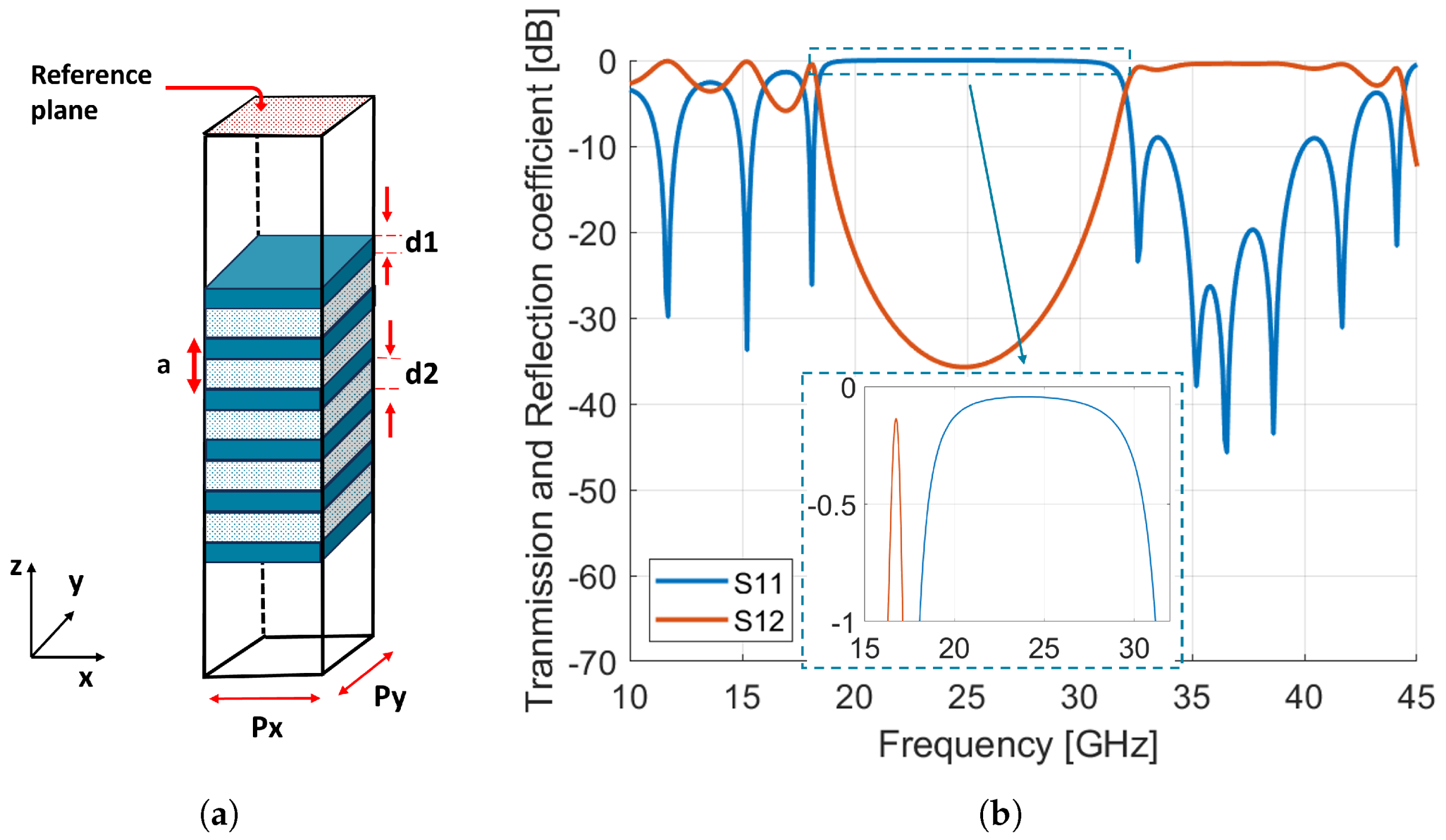

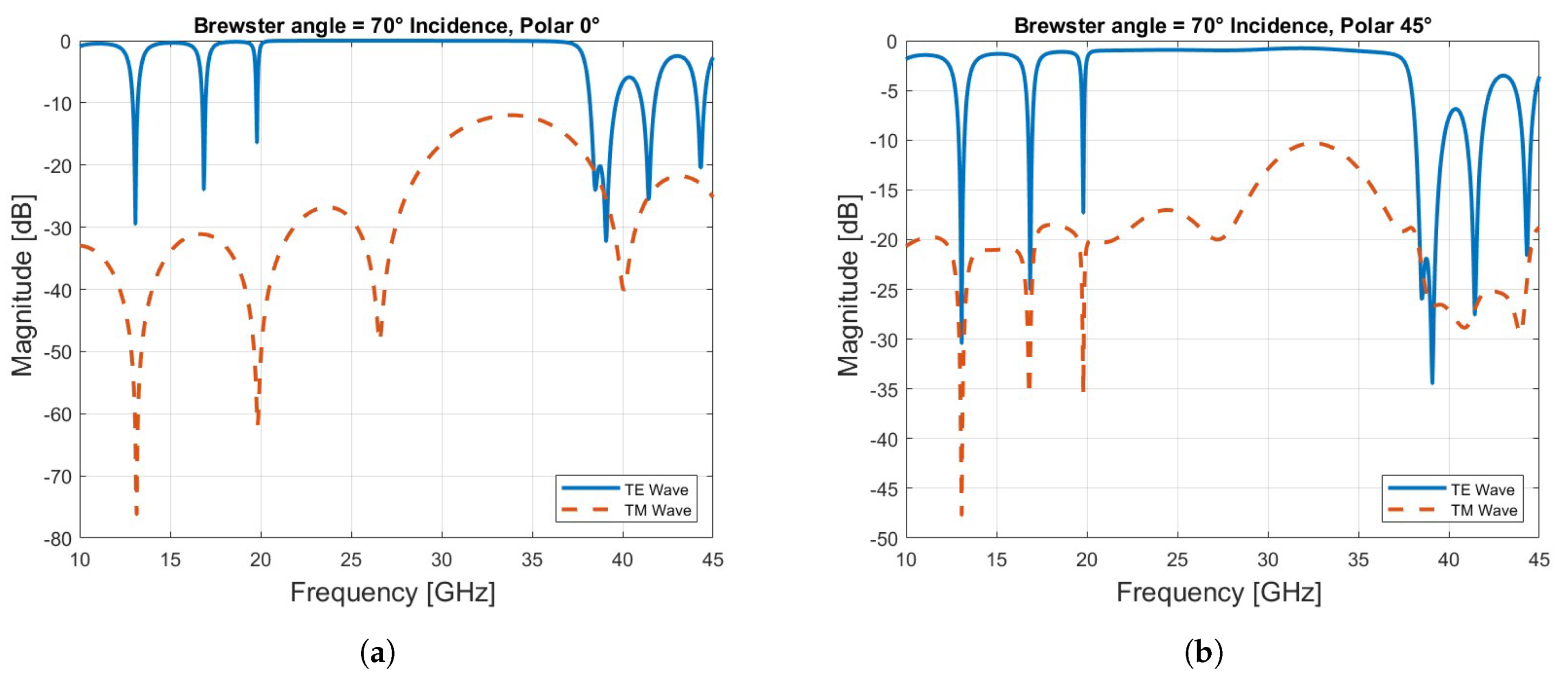
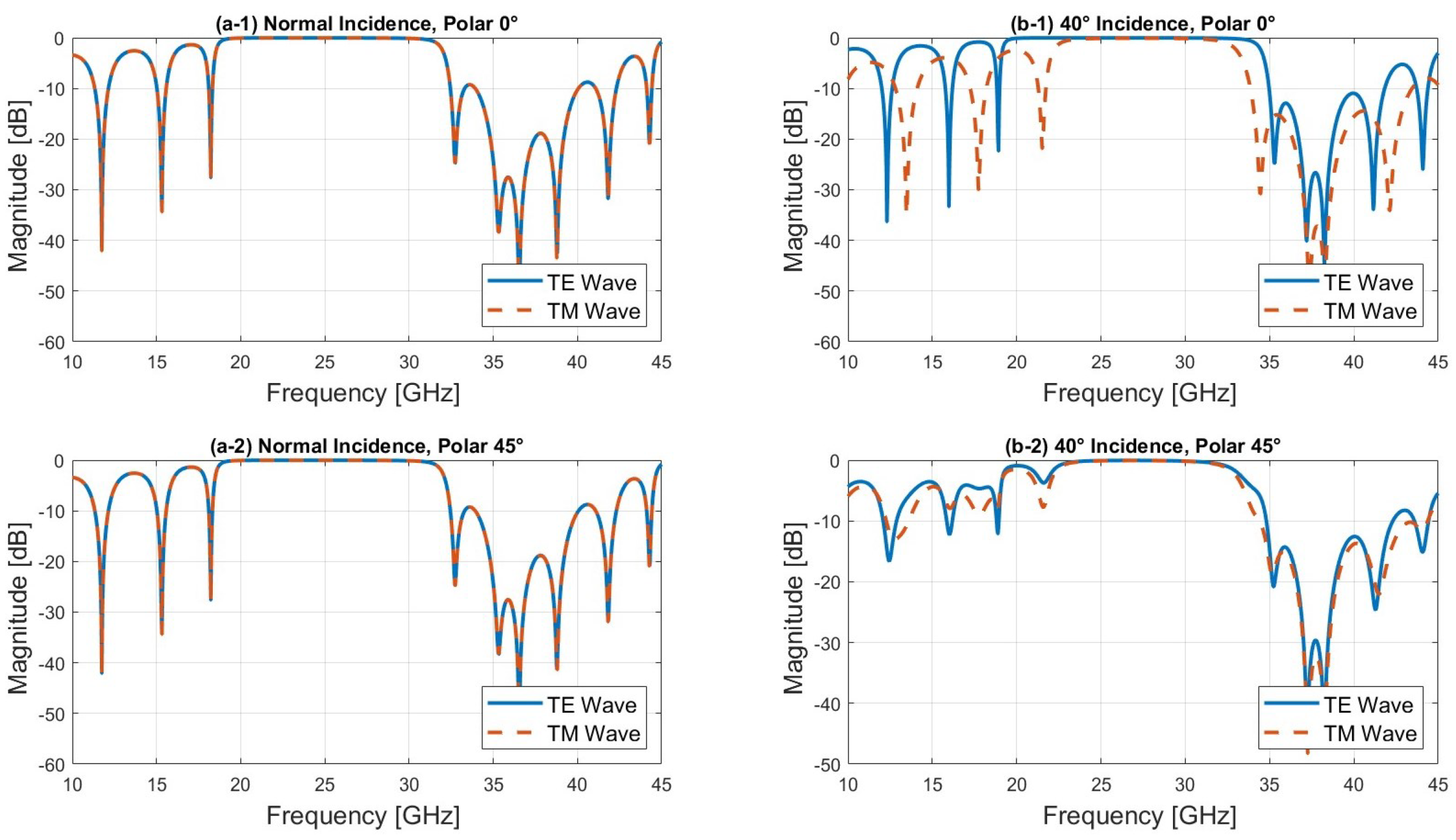



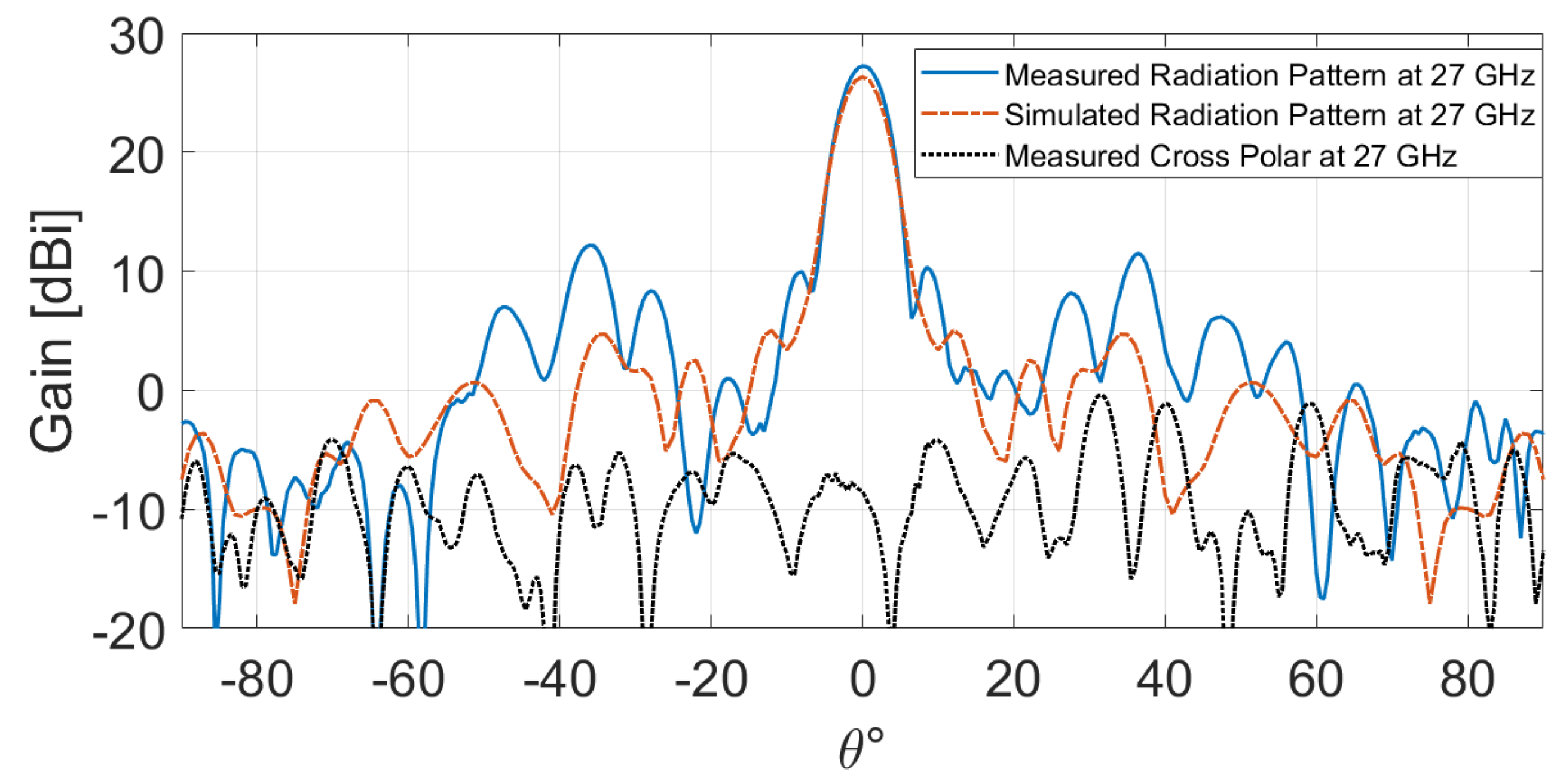
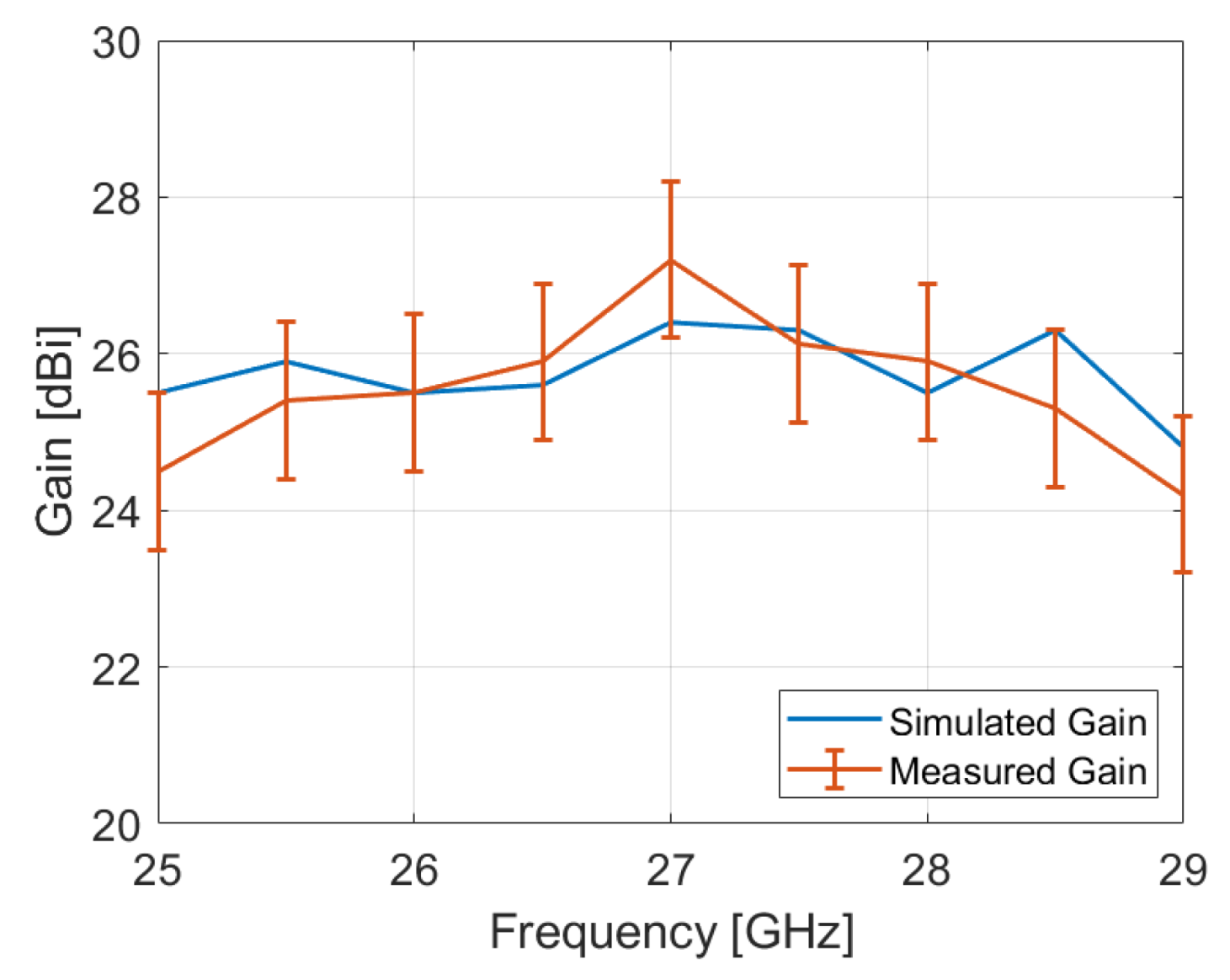

| Factor | Loss (dB) |
|---|---|
| Taper efficiency | 0.1 |
| Spillover loss | 2.7 |
| Blockage loss | 0.56 |
| Dielectric loss | 0.1 |
| Ref | [3] | [9] | [12] | [27] | [20] | This Work |
|---|---|---|---|---|---|---|
| Config | DR + Full ground | Multilayer phasing element + FSS | Bragg mirror | Shared aperture phasing element | Dielectric slabs + Full ground | Bragg mirror |
| Frequency (GHz) | 10/5.68 | 28.8/20 | 65/24 | 29.7/19.7 | 30 | 39 (future work)/27 |
| Transparency | not transparent | +/− 0.9 dB | not measured | not transparent | not transparent | +/− 0.32 dB |
| f/d ratio | 0.8 | 0.75 | 1.94 | 0.82 | 1.08 | 0.5 |
| Size (mm) | S.A 350 × 350 | S.A 400 × 400 | S.A 77 × 77 | C.A r = 194.4 | C.A r = 60 | S.A 121.5 × 121.5 |
| Gain (dBi) | 23/19 | 38.5/36.3 (Directivity) | 30.7/23.2 | 38.5/35.1 | 23.66 | 27.22 |
| Aperture efficiency (%) | 11.64/14.37 (estimated) | 57/48 | 33.54/43.75 (estimated) | 48.34/50.22 (estimated) | 16.32 (estimated) | 35.05 |
| Fabrication | N.A | PCB | 3D printing | PCB | 3D printing | 3D printing |
Disclaimer/Publisher’s Note: The statements, opinions and data contained in all publications are solely those of the individual author(s) and contributor(s) and not of MDPI and/or the editor(s). MDPI and/or the editor(s) disclaim responsibility for any injury to people or property resulting from any ideas, methods, instructions or products referred to in the content. |
© 2024 by the authors. Licensee MDPI, Basel, Switzerland. This article is an open access article distributed under the terms and conditions of the Creative Commons Attribution (CC BY) license (https://creativecommons.org/licenses/by/4.0/).
Share and Cite
Chekkar, W.; Lanteri, J.; Malvaux, T.; Sourice, J.; Lizzi, L.; Migliaccio, C.; Ferrero, F. A 3D-Printed Bi-Material Bragg-Based Reflectarray Antenna. Sensors 2024, 24, 6512. https://doi.org/10.3390/s24206512
Chekkar W, Lanteri J, Malvaux T, Sourice J, Lizzi L, Migliaccio C, Ferrero F. A 3D-Printed Bi-Material Bragg-Based Reflectarray Antenna. Sensors. 2024; 24(20):6512. https://doi.org/10.3390/s24206512
Chicago/Turabian StyleChekkar, Walid, Jerome Lanteri, Tom Malvaux, Julien Sourice, Leonardo Lizzi, Claire Migliaccio, and Fabien Ferrero. 2024. "A 3D-Printed Bi-Material Bragg-Based Reflectarray Antenna" Sensors 24, no. 20: 6512. https://doi.org/10.3390/s24206512





